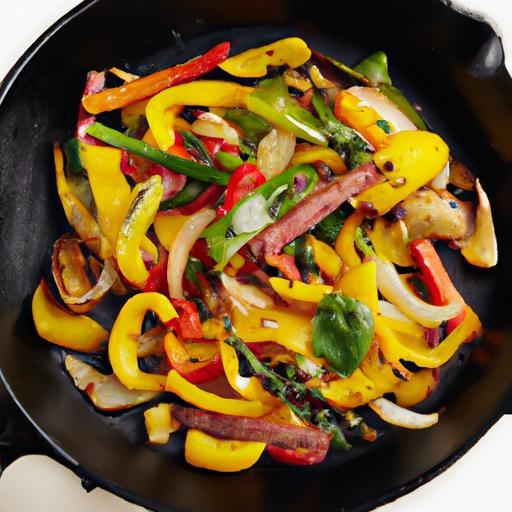In the world of culinary craftsmanship, few tools evoke the same blend of nostalgia and mastery as the cast iron skillet. Heavy, unyielding, and almost mythical in its reputation, this humble pan holds within its thick walls a world of secrets. But what exactly happens beneath that matte black surface when a steak sizzles or a cornbread bakes to golden perfection? Welcome to the sizzling heart of the kitchen-where science meets tradition. In this article, we’ll peel back the layers of seasoning, heat, and metallurgy to uncover the fascinating chemistry and physics that make cast iron skillets legendary. Prepare to discover why the art of searing is not just culinary magic, but a brilliant dance of molecules and heat transfer, engineered by centuries of human ingenuity.
Searing Secrets: The Science Behind Cast Iron Skillets transform everyday cooking into an extraordinary experience by harnessing the unmatched heat retention and even distribution qualities of cast iron. Imagine the intoxicating aroma of a perfectly seared steak, crusted to golden-brown perfection, a sensory delight that only a well-seasoned cast iron skillet can deliver. This method is steeped in culinary tradition, yet it thrives on precise temperature control and an understanding of the skillet’s chemical seasoning to deliver that flawless nonstick surface that many crave but few master.
Prep and Cook Time
- Preparation Time: 10 minutes
- Cook Time: 15 minutes
- Total Time: 25 minutes
Yield
Serves 2 hearty portions
Difficulty Level
Medium
Ingredients
- 2 thick-cut ribeye steaks (about 1-inch thick, room temperature)
- 1 tablespoon high smoke point oil (such as grapeseed or avocado oil)
- 2 sprigs fresh rosemary
- 3 cloves garlic, lightly crushed
- 2 tablespoons unsalted butter
- Coarse sea salt to taste
- Freshly ground black pepper to taste
Instructions
- Preheat your seasoned cast iron skillet over medium-high heat for about 5 minutes until it radiates even heat. This locks in the heat retention benefit essential for perfect searing.
- Pat steaks dry with paper towels. Moisture is the enemy of a crisp crust, so ensure dryness before seasoning.
- Generously season both sides of each steak with coarse sea salt and freshly ground black pepper.
- Add oil to the skillet and swirl to coat evenly once it just begins to shimmer but does not smoke, indicating optimal temperature control.
- Place steaks in skillet carefully; listen for the welcoming sizzle. Do not crowd the pan to maintain even heat distribution. Let steaks sear undisturbed for 3-4 minutes.
- Flip steaks and immediately add rosemary sprigs, crushed garlic, and butter. Tilt the pan slightly and baste steaks continuously with melted butter using a spoon for 2-3 minutes to fuse flavor and aid in caramelization.
- Check internal temperature with an instant-read thermometer for preferred doneness: 130°F for medium-rare. Adjust timing if needed.
- Remove steaks and let rest on a warm plate for 5 minutes to allow juices to redistribute, ensuring tender, juicy bites.
Chef’s Notes
- Seasoning Magic: The secret to nonstick bliss lies in your cast iron’s seasoning-the polymerized oil layers that build up with every cook enhance the skillet’s heat distribution and prevent sticking.
- Temperature Control: Heat your skillet gradually. Cast iron retains heat extraordinarily well but can develop hot spots if overheated abruptly.
- Alternate Oils: For subtle aroma, try experimenting with clarified butter or coconut oil, but always prioritize oils with high smoke points.
- Resting is Crucial: Never skip resting your steak; cutting too soon leads to dry meat and loss of flavor.
- Make Ahead: The skillet itself benefits from frequent use. Keep seasoning your cast iron with light oiling and baking between uses to preserve its legacy.
Serving Suggestions
Present your perfectly seared steak on a rustic wooden board to highlight its crusty exterior and juicy interior. Garnish with a sprinkle of flaky sea salt, a sprig of fresh rosemary, and a dollop of herbed butter melting slowly atop. Pair with creamy garlic mashed potatoes, roasted seasonal vegetables, and a robust red wine like Cabernet Sauvignon to elevate the meal into a celebration of classic culinary science and style.

Nutritional Information per Serving
| Calories | Protein | Carbs | Fat |
|---|---|---|---|
| 680 kcal | 62 g | 2 g | 48 g |
For further insights on maintaining your skillets and mastering temperature precision, visit our comprehensive guide to cast iron care. Also, check out this authoritative resource on cast iron skillet seasoning from Serious Eats to deepen your understanding and skills.
Q&A
Q&A: Searing Secrets – The Science Behind Cast Iron Skillets
Q1: Why do chefs rave about cast iron skillets for searing meats?
A1: Cast iron skillets are the superheroes of searing because of their exceptional heat retention. When heated, cast iron holds onto that intense temperature like a dragon guards its treasure. This consistent, even heat ensures the surface of your meat hits the perfect Maillard reaction zone-between 300°F and 500°F-where proteins and sugars dance together to create that irresistible, caramelized crust.
Q2: What exactly is the Maillard reaction, and why does it matter?
A2: The Maillard reaction is the magical chemical process responsible for the golden-brown flavor and aroma of seared food. When your cast iron skillet smokes hot, amino acids and reducing sugars in the meat undergo a complex transformation, creating hundreds of flavorful compounds. This is the science behind why a simple piece of meat can taste like a gourmet delight after a good sear.
Q3: How does the material of cast iron influence cooking compared to stainless steel or aluminum?
A3: Cast iron’s secret superpower lies in its density and thermal mass. Unlike lightweight aluminum that heats quickly but cools fast, cast iron takes longer to heat but maintains a steady, even temperature once hot-think of it as a slow-burning campfire vs. a flickering flame. Stainless steel can offer good heat distribution but not the same retention; cast iron’s heavyweight nature gives you unparalleled control for a perfect sear every time.
Q4: Can seasoning a cast iron skillet affect the searing process?
A4: Absolutely! Seasoning is the skillet’s natural non-stick armor, created by polymerized oils baked onto the surface. This smooth, slick layer not only prevents sticking but also promotes better heat transfer and browning. A well-seasoned pan encourages those prized crusty edges while protecting the skillet from rust-a true culinary symbiosis.
Q5: What common mistakes should home cooks avoid when searing with cast iron?
A5: The biggest blunders include starting with a cold pan, overcrowding the skillet, and using low heat. Cast iron needs time to reach the right sizzling temperature-think of it like warming a forge for your cooking craft. Overcrowding drops the pan’s temperature instantly, causing food to steam rather than sear. And low heat? That’s just missing the show-without high heat, the Maillard reaction fumbles, and you’re left with pale, unappetizing meat.
Q6: How do you maintain the “black gold” to keep it searing-ready for years?
A6: After each culinary battle, clean your cast iron with warm water and a brush-skip soap and soaking to preserve the seasoning. Dry it thoroughly, then rub a light coat of oil to keep the surface hydrated. Store it in a dry spot, and occasionally give it a full seasoning treatment. Treat your skillet like a trusted companion, and it will reward you with that perfect sear again and again.
Q7: Is cast iron suitable for all kinds of searing, or is it better for certain foods?
A7: While cast iron excels at searing steaks, chicken, and pork chops thanks to its heat retention, it’s also a formidable ally for vegetables and even fruits needing caramelization. Its ability to maintain steady heat allows you to develop complex flavors without burning delicate ingredients-just mind the cooking time and temperature. In short, cast iron is the versatile canvas for your culinary artistry.
In the alchemy of cooking, cast iron skillets stand as the ancient wizards, transforming raw ingredients into seared masterpieces through science and simple care. Master these searing secrets, and your cast iron will become a key to unlocking a world of flavor.
Future Outlook
As the final sizzle fades and your meal emerges perfectly seared, it’s clear that the humble cast iron skillet is more than just a kitchen tool-it’s a seasoned scientist in disguise. From its unparalleled heat retention to the microscopic magic of seasoning layers, every inch of cast iron is a testament to chemistry and craftsmanship working hand in hand. So next time you reach for that hefty pan, remember: you’re not just cooking, you’re engaging in a timeless culinary alchemy where science meets savory. Embrace the secrets, master the sear, and let your cast iron skillet continue to transform simple ingredients into mouthwatering masterpieces.


